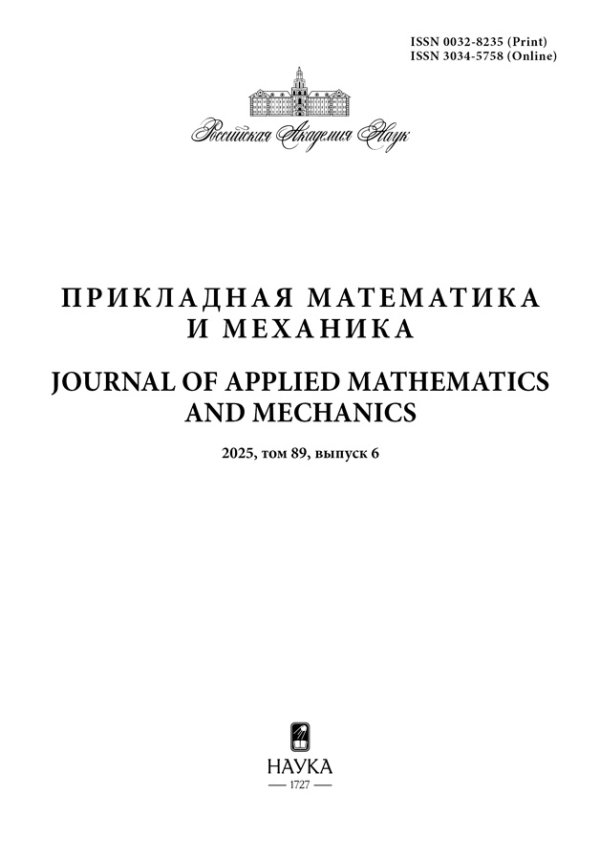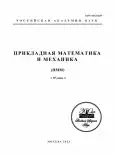Vol 87, No 1 (2023)
Articles
One Class of Resonance Precession Motions of a Rigid Body under the Action of Three Homogeneous Force Fields
Abstract
The article is devoted to the problem on motion of a rigid body with a fixed point under the action of a force field, which is the superposition of three homogeneous force fields. Existence conditions are investigated for precession motions, which are characterized by the following property: the angular velocity of the precession of the body is two times more than the angular velocity of its proper rotation. It is established that the body has the dynamic symmetry with respect to an axis making a constant angle with a vector fixed in the immovable space. In the case of the body with the spherical mass distribution this angle equals to \({\text{arccos}}\frac{1}{4}\). Solution of the equations of motion of the body is expressed through the elliptic functions of time.
 3-18
3-18


About the Lack of Controllability in Models of “Naive Mechanics”. Three Exceptional Cases
Abstract
The problem of boundary controllability is considered for a wide class of models, which can be conditionally called “naive mechanics”. It is proved that for all models of “naive mechanics”, except for the three cases, there is no controllability to rest. All these three cases are classical examples of equations, two of which require additional study of the controllability property.
 19-25
19-25


Hypersonic Nonequilibrium Flow around Sharp Edge
Abstract
A regularized problem has been formulated to describe the flow of a molecular gas in a hypersonic macrokinetic nonequilibrium thin viscous shock layer (kinetic TVSL) near a sharp edge. It is shown that the solution of the regularized kinetic TVSL problem on the sharp edge, the description of friction and heat transfer coincides with the solution of the Navier–Stokes analogue of this TVSL problem. It is shown that in the kinetic TVSL the friction stress and the normal heat flow on the wall in the vicinity of the sharp edge are identical with the corresponding values in the Navier–Stokes TVSL. The similarity of currents near the sharp edge in the kinetic and Navier–Stokes versions of the TVSL is indicated. A method for constructing a solution to the kinetic TVSL problem for the vicinity of a sharp edge based on the Navier–Stokes TVSL solution is indicated. A formula is obtained for calculating the pressure on the surface in the kinetic TVSL flow near the sharp edge through the components of the solution (on the wall) of the Navier–Stokes TVSL flow problem.
 26-35
26-35


On the Problem of Determining the Position of the Source of Internal Waves
Abstract
When bodies move in a continuously stratified fluid, the steady wave field moves along with the body and form a field of so-called associated internal waves. The flow incident on the body is usually assumed to be constant; non-stationary waves generated at the initial stage of motion are neglected. In this case, the body is modeled by point mass sources, and the wave field is found using the Green’s function method, followed by the use of asymptotic expansions based on the stationary phase method [1]. The inverse problem of determining the position of the source is solved from the wave field.
 36-44
36-44


Schemes of the Experiments for Determining the Kernels of Some Difference-Type Operators for Media with Nonrelaxing Volume
Abstract
Within the framework of integral constitutive relations for linear isotropic viscoelastic media with difference-type kernels in the case of a nonrelaxing volume, possible, complementary to the known, setup experiments for determining the kernels of Ilyushin operators \({{\overset{\lower0.5em\hbox{$\smash{\scriptscriptstyle\smile}$}}{g} }_{\beta }}\) are proposed. One of them is based on the use of a sample from an auxiliary viscoelastic solid, the material functions of which are related to the creep function and the volume compression module of the given material. Similar schemes of setup experiments for finding operator kernels \({{\overset{\lower0.5em\hbox{$\smash{\scriptscriptstyle\smile}$}}{h} }_{\gamma }}\), in a certain sense conjugated with \({{\overset{\lower0.5em\hbox{$\smash{\scriptscriptstyle\smile}$}}{g} }_{\beta }}\), are also proposed.
 45-52
45-52


Doubly Periodic Contact Problems for a Layer with an Unknown Contact Zone
Abstract
Doubly periodic contact problems are considered for a layer with an unknown contact domain. One face of the layer is subjected to sliding support or rigidly fixed. The problems are reduced to integral equations the kernels of which do not contain integrals. For full contact of the other layer face with a two-dimensional sinusoidal rigid surface, the problems have exact solutions used to verify computer programs realizing the numerical method of Galanov nonlinear integral equations which allows us to determine the contact domain and the contact pressure simultaneously. Mechanical characteristics are calculated for indentation of the system of elliptic paraboloids, the passage from discrete to continuous contact zones is investigated.
 53-62
53-62


One-Dimensional Spatial Boundary Value Problems of the Connected Thermoelasticity. Generalized Functions Method
Abstract
Problems of definition of thermotension of a thermoelastic core with use of model of the connected thermoelasticity are considered. In this case in the equation of heat conductivity there is the divergence of speed of the movement of material points of the rod, and the elasticity equations contains the temperature gradient. On the basis of generalized functions method the generalized solutions of non-stationary and stationary boundary value problems have been solved at action of the power and thermal sources of various type including ones described singular generalized functions, under various boundary conditions on the ends of a core. Thermoshock waves which arise in such designs at action of impact loads and heat fluxes are considered, conditions on their fronts are received. The uniqueness of the set boundary tasks, including taking into account shock waves has been proved. Regular integral representation of the generalized solutions are given, which give the analytical solution of the tasks. Numerical implementation of solutions of a number of direct, return and semi-return boundary value problems of stationary fluctuations is carried out and results of computer experiments are presented
 63-80
63-80


About One Approach to the Construction of a Solution to the Problem of Coal and Methane Emissions from the Marginal Zone of the Formation
Abstract
Based on the model of the geomechanical state of a coal massif containing a coal seam with a fragile layer, a mining working and the ideas developed by S.A. Khristianovich about gas-dynamic processes in the development of coal seams, a solving of the ejection of the marginal part of the formation is constructed. The conditions for the occurrence of gas-dynamic phenomena are formulated, which manifest themselves in the form of the formation first of a main crack in a formation with free methane, then the formation of a crushing wave in it, followed by the release of a jumper and a mixture of crushed coal and gas into mine working.
 81-111
81-111


XIII Всероссийский съезд по теоретической и прикладной механике
 112-112
112-112












